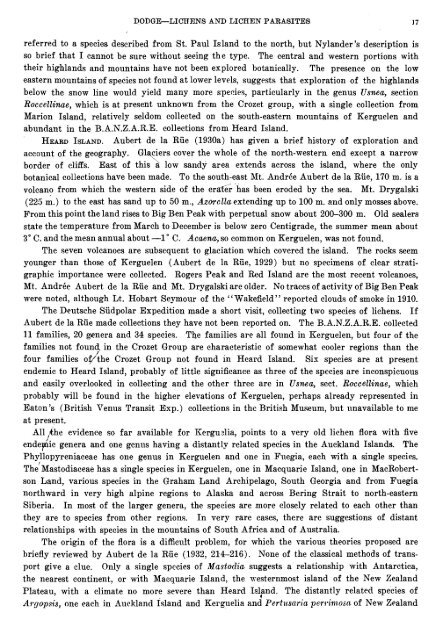Create successful ePaper yourself
Turn your PDF publications into a flip-book with our unique Google optimized e-Paper software.
DODGE--LICETENS <strong>AND</strong> <strong>LICHEN</strong> <strong>PARASITES</strong> 17<br />
referred to a species described from St. Paul Island to the north, but Nylander's description is<br />
so brief that I cannot be sure without seeing the type. The central and western portions with<br />
their highlands and mountains have not been explored botanically. The presence on the low<br />
eastern mountains of species not found at lower levels, suggests that exploration of the highlands<br />
below the snow line would yield many more specie$, particularly in the genus Usnea, section<br />
Roccellinae, which is at present unknown from the Crozet group, with a single collection from<br />
Marion Island, relatively seldom collected on the south-eastern mountains of Kerguelen and<br />
abundant in the B.A.N.Z.A.R.E. collections from Heard Island.<br />
HEARD ISL<strong>AND</strong>. Aubert de la Rue (1930a) has given a brief history of exploration and<br />
account of the geography. Glqciers cover the whole of the north-western end except a narrow<br />
border of cliffs. East of this a low sandy area extends across the island, where the only<br />
botanical collections have been made. To the south-east Mt. Andree Aubert de la Rue, 170 m. is a<br />
volcano from which the western side of the erater has been eroded by the sea. Mt. Drygalski<br />
(225 6.) to the east has sand up to 50 m., Amrella extending up to 100 m. and only mosses above.<br />
From this point the land rises to Big Ben Peak with perpetual snow about 200-300 m. Old sealers<br />
state the temperature from March to December is below zero Centigrade, the summer mean about<br />
3" C. and the mean annual about -lo C. Acaena, so common on Kerguelen, was not found.<br />
The seven volcanoes are subsequent to glaciation which covered the island. The rocks seem<br />
younger than those of Kerguelen (Subert de la Rue, 1929) but no specimens of clear stratigraphic<br />
importance were collected. Rogers Peak and Red Island are the most recent volcanoes,<br />
Mt. AndrCe Aubert de la Rue and Mt. Drygalski are older. No traces of activity of Big Ben Peak<br />
were noted, although Lt. Hobart Seymour of the "Wakefield" reported clouds of smoke in 1910.<br />
The Deutsche Siidpolar Expedition made a short visit, collecting two species of lichens. If<br />
Aubert de la Rue made collections they have not been reported on. The B.A.N.Z.A.R.E. collected<br />
31 families, 20 genera and 34 species. The families are all found in IZerguelen, but four of the<br />
families not found in the Crozet Group are characteristic of somewhat cooler regions than the<br />
four families of;'ihe Crozet Group not found in Heard [sland. Six species are at present<br />
endemic to Heard Island, probably of little significance as three of the species are inconspicuous<br />
and easily overlooked in collecting and the other three are in Usnea, sect. Roccellinae, which<br />
probably will be found in the higher elevations of Kerguelen, perhaps already represented in<br />
Eaton's (British Venlis Transit Exp.) collections in the British Museum, but unavailable to me<br />
at present.<br />
Al1,khe evidence so far available for Rergudia, points to a very old lichen flora with five<br />
endefr;ic genera and one genus having a distantly related species in the Auckland Islands. The<br />
Phyllopyreniaceae has one genus in Kerguelen and one in Fnegia, each with a single species.<br />
~he~~astodiaceae has a single species in Kerguelen, one in Macquarie Island, one in MacRobertson<br />
Land, various species in the Graham Land Archipelago, South Georgia and from Fuegia<br />
northward in very high alpine regions to Alaska and across Bering Strait to north-eastern<br />
Siberia. In most of the larger genera, the species are more closely related to each other than<br />
they are to species from other regions. In very rare cases, there are suggestions of distant<br />
relationships with species in the mountains of South Africa and of Australia.<br />
The origin of the flora is a difficult problem, for which the various theories proposed are<br />
briefly reviewed by Aubert de la Rue (1932, 214-216). None of the classical methods of transport<br />
give a clue. Only a single species of Mastoclia suggests a relationship with Antarctica,<br />
the nearest continent, or with Macquarie Island, the ~~esternmost island of the New Zealand<br />
Plateau, with a climate no more severe than Heard Island. The distantly related species of<br />
A~gopsis, one each in Alickland Island and Kerplielia and Pertrisnria perrinlosn of New Zealand

















